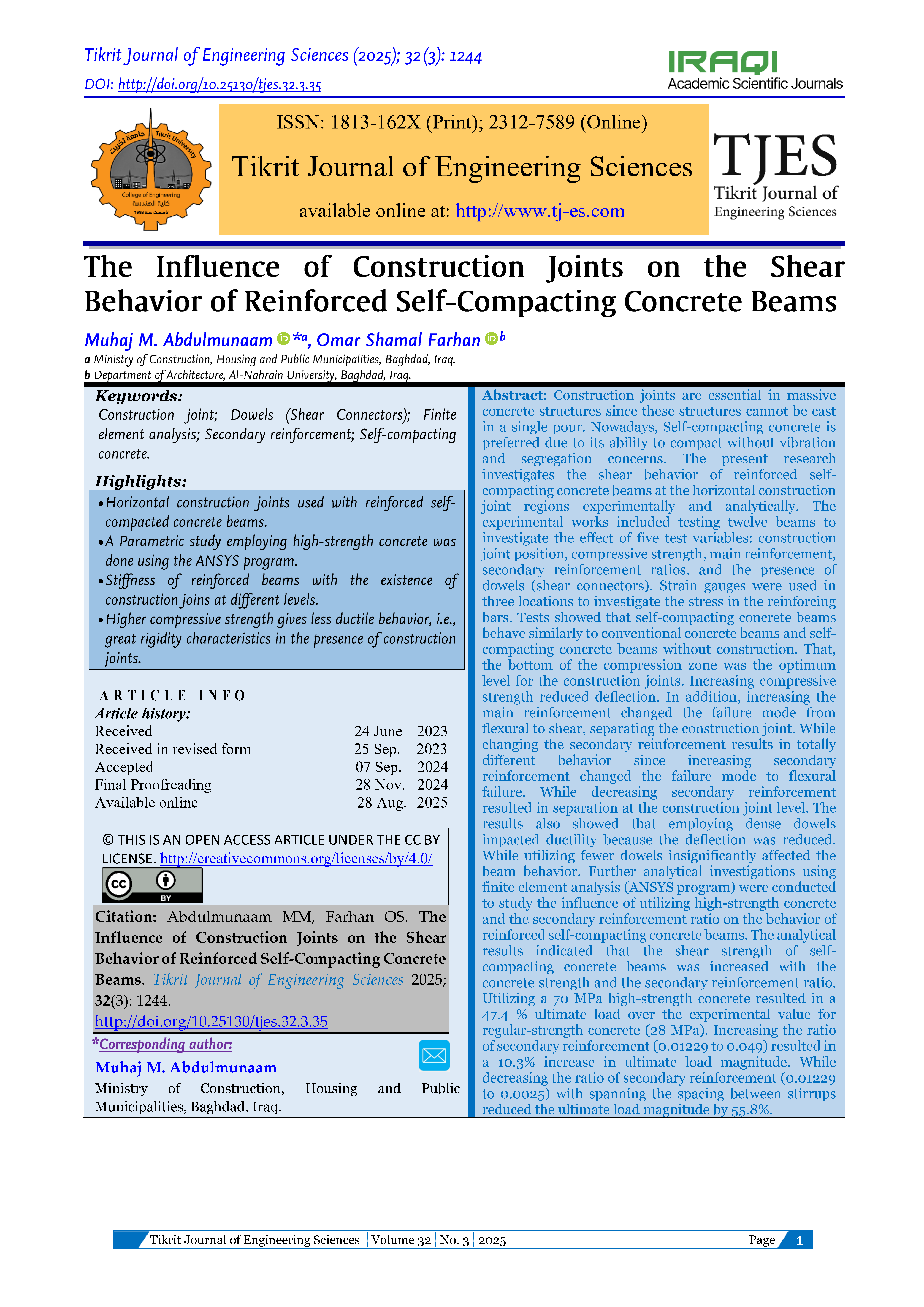The Influence of Construction Joints on the Shear Behavior of Reinforced Self-Compacting Concrete Beams
محتوى المقالة الرئيسي
الملخص
Construction joints are essential in massive concrete structures since these structures cannot be cast in a single pour. Nowadays, Self-compacting concrete is preferred due to its ability to compact without vibration and segregation concerns. The present research investigates the shear behavior of reinforced self-compacting concrete beams at the horizontal construction joint regions experimentally and analytically. The experimental works included testing twelve beams to investigate the effect of five test variables: construction joint position, compressive strength, main reinforcement, secondary reinforcement ratios, and the presence of dowels (shear connectors). Strain gauges were used in three locations to investigate the stress in the reinforcing bars. Tests showed that self-compacting concrete beams behave similarly to conventional concrete beams and self-compacting concrete beams without construction. That, the bottom of the compression zone was the optimum level for the construction joints. Increasing compressive strength reduced deflection. In addition, increasing the main reinforcement changed the failure mode from flexural to shear, separating the construction joint. While changing the secondary reinforcement results in totally different behavior since increasing secondary reinforcement changed the failure mode to flexural failure. While decreasing secondary reinforcement resulted in separation at the construction joint level. The results also showed that employing dense dowels impacted ductility because the deflection was reduced. While utilizing fewer dowels insignificantly affected the beam behavior. Further analytical investigations using finite element analysis (ANSYS program) were conducted to study the influence of utilizing high-strength concrete and the secondary reinforcement ratio on the behavior of reinforced self-compacting concrete beams. The analytical results indicated that the shear strength of self-compacting concrete beams was increased with the concrete strength and the secondary reinforcement ratio. Utilizing a 70 MPa high-strength concrete resulted in a 47.4 % ultimate load over the experimental value for regular-strength concrete (28 MPa). Increasing the ratio of secondary reinforcement (0.01229 to 0.049) resulted in a 10.3% increase in ultimate load magnitude. While decreasing the ratio of secondary reinforcement (0.01229 to 0.0025) with spanning the spacing between stirrups reduced the ultimate load magnitude by 55.8%.
المقاييس
تفاصيل المقالة

هذا العمل مرخص بموجب Creative Commons Attribution 4.0 International License.
THIS IS AN OPEN ACCESS ARTICLE UNDER THE CC BY LICENSE http://creativecommons.org/licenses/by/4.0/
##plugins.generic.plaudit.displayName##
المراجع
Fintel M. Handbook of Concrete Engineering. New York: Van Nostrand Reinhold Company; 1985. DOI: https://doi.org/10.1007/978-1-4757-0857-8
Yousifani AH. Investigation of the Behavior of Reinforced Concrete Beams with Construction Joints Using Nonlinear Three-Dimensional Finite Elements. [M.Sc. Thesis]. Baghdad, Iraq: University of Technology; 2004.
Alghazali HH, Myers JJ. Shear Behavior of Full-Scale High Volume Fly Ash-Self Consolidating. Construction and Building Materials 2017; 157:161-171. DOI: https://doi.org/10.1016/j.conbuildmat.2017.09.061
Jabir HA, Salman TS, Mhalhal JM. Effect of Construction Joints on the Behavior of Reinforced Concrete Beams. Journal of Engineering 2017; 23(5):47-60. DOI: https://doi.org/10.31026/j.eng.2017.05.04
Abbas AN, Al-Naely HK, Abdulzahra HH, Al-Khafaji ZS. Structural Behavior of Reinforced Concrete Beams Having Construction Joints at Different Elevation. International Journal of Civil Engineering and Technology 2018; 9(13):712-720.
Ismael MA, Hameed YM, Abd HJ. Effect of Construction Joint on Structural Performance of Reinforced Self-Compacting Concrete Beams. International Journal of Civil Engineering and Technology 2019; 10(1):297-306.
Ibrahim MS, Solomon Y, Demere A, Shiferaw A, Sultan A, Moges A, Dawit K. Effect of Construction Joint on the Shear Behavior of Reinforced Concrete Beams. Fib Symposium Concrete Structures for Resilient Society 2020; China (Online).
Mathew A, Nazeer M. Flexural Behavior of Reinforced Concrete Beams with Construction Joints. International Research Journal of Engineering and Technology 2020; 7(6):3789-3796.
Al-Rifaie A, Al-Hassani H, Shubbar AA. Flexural Behavior of Reinforced Concrete Beams with Horizontal Construction Joints. IOP Conference Series: Materials Science and Engineering 2021; 1090:012003. DOI: https://doi.org/10.1088/1757-899X/1090/1/012003
Budi AS, Safitri E, Sangadji S, Kristiawan SA. Shear Strength of HVFA-SCC Beams without Stirrups. Buildings 2021; 11(4):177. DOI: https://doi.org/10.3390/buildings11040177
Iraqi Standard Specifications No. 5. Portland Cement. Baghdad, Iraq: Iraqi Central Organization for Standardization and Quality Control; 1984. (In Arabic)
Iraqi Standard Specification No. 45. Aggregate from Natural Sources for Concrete. Baghdad, Iraq: The Iraqi Central Agency for Standardization and Quality Control; 1984. (In Arabic)
EFNARC. Specification and Guidelines for Self-Compacting Concrete. Farnham, UK: EFNARC; 2002.
ASTM C494/C494M-19. Standard Specification for Chemical Admixtures for Concrete. West Conshohocken, PA: ASTM International; 2019.
ASTM A615/A615M-20. Standard Specification for Deformed and Plain Carbon-Steel Bars for Concrete Reinforcement. West Conshohocken, PA: ASTM International; 2020.
Jasim AT. Production of Self-Compacting Concrete Using Limestone. Journal of Kerbala University 2011; 1:87-100.
Farhan OS. Behavior of Self Compacting Concrete Deep Beams under Repeated Loading. [Ph.D. Dissertation]. Baghdad, Iraq: Al-Nahrain University; 2014.
ANSYS. ANSYS Help. Release 16.1.
Gigar FZ. Experimental Investigation of Construction Joints in RC Beams. [M.Sc. Thesis]. Addis Ababa, Ethiopia: Addis Ababa University; 2015.
Randl N. Design Recommendations for Interface Shear Transfer in MC 2010. Structural Concrete 2013; 14(3): 230-241. DOI: https://doi.org/10.1002/suco.201300003
Dawe DJ. Matrix and Finite Element Displacement Analysis of Structures. Oxford, UK: Clarendon Press; 1984.





